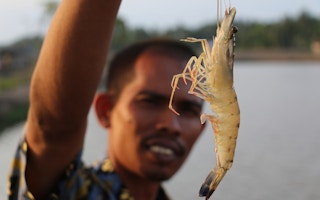Along with many lives in the 2004 tsunami countless livelihoods were also lost across all sectors. Particularly badly hit was the aquaculture industry which supported 50,000 jobs in Aceh, Indonesia alone.
To continue reading, subscribe to Eco‑Business.
There's something for everyone. We offer a range of subscription plans.
- Access our stories and receive our Insights Weekly newsletter with the free EB Member plan.
- Unlock unlimited access to our content and archive with EB Circle.
- Publish your content with EB Premium.
Post tsunami development efforts focused on grants to successfully rebuild aquaculture in the region. However once the handouts stopped, many farmers were left ill-equipped to continue to improve their businesses. More importantly, they lacked access to credit for vital supplies like feed and seed.
Now international research organization, WorldFish, global sustainable trade initiative, IDH and partners are working with the Aceh Aquaculture Cooperative (AAC) to establish sustainable business models for the farming of black tiger shrimp, a premium product in foreign markets that, due to its requirement for little or no chemicals and feed, is also an environmentally friendly alternative to other commonly available shrimp varieties.
Within developing and emerging countries, small aquaculture enterprises, employing five or fewer people, make up the majority of producers and are estimated to supply up to 80 percent of aquaculture products. While more private investment is now flowing into the growing aquaculture sector globally most fails to reach the majority, smallholder farmers.
Black tiger shrimp is widely farmed in Aceh and requires near zero feed and chemical input which means that it is produced ‘extensively’ compared to other types of shrimp that requite ‘intensive’ production methods and high amounts of feed and fertilizer. Indeed ‘extensive’ farming practices lead to notionally ‘organically’ produced shrimp.
As well as its green credentials, and thanks to its size and physical appearance, the black tiger shrimp is highly prized in international markets and attracts a good price, at least for the restaurateurs.
The challenges are for farmers to gain a fairer share of that premium price, find access to good credit for feed and seed and prove their environmental credentials.
And that’s where international research agency WorldFish and IDH have stepped in to provide training in best management practices that can help towards certification and provide links to financial institutions and buyers.
In 2014, with the help of WorldFish, IDH and others an aquaculture improvement plan commenced to support the Aceh Aquaculture Co-operative (AAC). The plan involved training programs to help farmers apply best management practices, learn about land and water management, implement new sustainable practices and traceability mechanisms, as well as learn financial and business management skills.
The program was also structured to lay the groundwork through benchmark gap analyses to meet certification standards such as AquaGAP, ASC (Aquaculture Stewardship Council) and the Southeast Asian Shrimp Aquaculture Improvement Protocol.
These certification programs potentially open the door to higher value global markets which are increasingly requiring a traceable and certifiable product to meet changing consumer tastes.
Smallholders in aquaculture in developing markets do not have the collateral nor the credit history to access commercial loans from banks and other institutions. Added to this, aquaculture is traditionally seen as a risk by financers, partly because they have little experience in the sector and data to make the financial case is lacking.
But with the transformation of the AAC brought about by the implementation of best management practices and a robust administration, Rabobank Foundation was willing to offer a loan so that AAC can provide microcredit to its members at competitive interest rates.
“
A successful transition to a commercially sustainable business underlines the fact that these small scale businesses can become bankable commercial enterprises that are profit and growth focused.
The AAC uses the cash injection to offer seed and feed to farmers on credit. This has been a transformational change for the farmers. With the adoption of new techniques, less feed and better seed resulting in higher yields, the AAC farmers can now compete at a level which was previously inaccessible to them.
To facilitate a fairer price for the farmers, WorldFish has been working with value chain specialist Ecohub, along with middlemen and processors. The collaboration is bearing fruit with the first shipment to high-end Singaporean restaurants just having taken place.
The hope is that this will pave the way for a commitment from large hotel and restaurant chains and cement a long-term sustainable future for the farmers, by delivering a premium price for their product.
The investment in the transition from donor funded projects to commercially sustainable businesses is proving to be an investment in more transparent, fairer, and environmentally sustainable supply chains.
An injection of finance to enable the transition from a supported to a sustainable business model through the start-up and establishment to a growth phase was critical.
And a successful transition to a commercially sustainable business underlines the fact that these small scale businesses can become bankable commercial enterprises that are profit and growth focused, once they are shown to be well-managed, grounded in local regulatory and institutional rules, with strong procedures and solid management systems in place.
The experience of working with the AAC and Aceh black tiger shrimp farmers to grow a co-operative and sustainable business model has been a successful case study that WorldFish and IDH are keen to share with others and replicate with other groups of farmers in the region and globally.
Toby Johnson is head of communications, WorldFish and Daan de Wit is head of communications, IDH. This post was written exclusively for Eco-Business.











